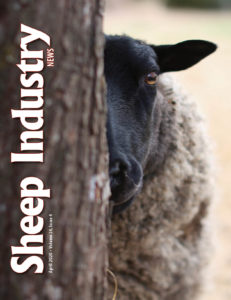JULIE STEPANEK SHIFLETT, PH.D.
Juniper Economic Consulting
Slaughter lamb prices saw a four-year high in January and February. Slaughter lamb prices typically strengthen toward Easter, but often don’t start at the high levels we’ve seen this year. Prices historically look like an inverted ‘U’ during the year – they climb in January to June and then decline through the remainder of the year. It is uncertain whether the current hot market will strengthen further in the next few months.
Slaughter lamb prices in formula trade averaged $297.24 per cwt. on a carcass basis in February, up 2 percent monthly and up 13 percent year-on-year. Carcass weights inched up 2 percent to
81 lbs. in February. On a live-equivalent basis, slaughter lamb prices averaged $147.53 per cwt.
Live, negotiated slaughter lambs averaged $161.27 per cwt. in February, up 5 percent monthly and up 22 percent year-on-year. Harvest weights averaged 148 lbs., down 2 percent monthly and down 9 percent year-on-year.
Pelts Remained Depressed
The highest quality pelt – unshorn supreme – ranged from -$3.00 to $2.92 per piece in February. While the low end remained steady with January, the high-end saw a 72 percent lift from $1.70 per piece in January.
At the ASI Annual Convention in January, the Nugget Company explained why lambskin demand has been depressed. Important markets of China, Russia and Europe have been relatively weak. Warmer winters in these economies have also hurt sales. Further, the animal rights movement is affecting lambskin sales. The development of low-cost synthetics such as vegan leather (made from polyurethane) is hurting the industry. Lastly, the cost of producing shearling leather has been increasing.
Commercial Feeder Prices Up
Commercial feeder lamb prices at auction in Sioux Falls, S.D., averaged $225 per cwt. in February, down 4 percent monthly and up 20 percent year-on-year. In February, 1,700 head of feeder lambs in direct trade were sold out of California at 130 lbs. for $156.50 per cwt.
Commercial feeder lamb prices continued to see pronounced seasonality in prices in 2019: highest around March and then lower from August through October. Feeder prices are the lowest during late summer and fall because that is when available supplies are the largest as spring-born lambs head to feedlots.
There is reporting that American lamb industry seasonality causes inefficiencies and market volatility (American Lamb Board, 2018). This volatility might also depress producer returns. Most American lambs are born during the spring and thus, most producers sell feeder lambs during the lowest time of the year, when all supplies head to market, creating a glut.
According to David Anderson, professor and extension economist at Texas A&M University, the introduction of aseasonal breeding – to produce out-of-season lambs – might not be profitable. Aseasonal breeding is biologically possible, but the economics also have to make sense: It has to be profitable to individual producers. Furthermore, markets work. Markets can smooth out seasonality using imports, stocks and lamb feeding (1/23/20).
Meat Market Higher
In February, the wholesale composite averaged $423.08 per cwt., up 1 percent monthly and up 12 percent year-on-year. The leg, trotter-off, saw the sharpest gain monthly among primals, up 12 percent monthly to $436.57 per cwt. The loin, trimmed 4×4, also was up, 2 percent monthly to $534.54 per cwt. The rack and shoulder were lower monthly in February. The 8-rib rack, medium fell 1 percent to $877.68 per cwt. and the shoulder, square-cut, averaged $326.07 per cwt., down only slightly for the month.
The shoulder continued its unprecedented climb in February, up 18 percent year-on-year. The leg was also up, 12 percent higher year-on-year. The loin lost 3 percent in February year-on-year. The rack was down 2 percent annually.
Domestic Production and Trade
In January and February, total estimated lamb harvest was 303,124 head, down 1 percent year-on-year. Total estimated lamb production was 14.8 million lbs., down 3 percent year-on-year.
Lamb supplies are tighter and more current with less back fat present. In January, the percent of lambs yield grading 4s and 5s was 26 percent. This is 24-percent lower than January 2019, when 4s and 5s totaled 34 percent of all lambs graded.
Lamb and mutton in cold storage averaged 36.9 million lbs. at the beginning of February, up 6 percent monthly and down 4 percent year-on-year.
Available supplies continue to contract. The numbers of lambs reported in Colorado feedlots was 117,201 head on March 1, down 8 percent monthly and down 3 percent year-on-year. March’s Colorado feedlot inventory was 19 percent lower than March’s five-year average for the month, which means it was down more than 27,000 head. Based on slaughter price averages in 2018 and 2019, this shortfall of 27,000 head is a loss in gross profit of about $6 million to feeders and producers.
In 2019, Australian lamb imports totaled 162.0 million lbs., up 8 percent year-on-year. New Zealand imports were up 3 percent to 54.7 million lbs. and total lamb imports were up 6 percent to 218.5 million lbs.
In 2019, lamb and mutton exports fell 2 percent year-on-year to 5.7 million lbs. Lamb exports were off by 6 percent to 738,000 lbs. and mutton imports were down 1 percent to 5.0 million lbs. Mexico was the largest export market by volume while El Salvador was the second largest export market.
Forecasts
According to the Livestock Marketing Information Center, slaughter lamb harvest in the second quarter could see a sharp contraction compared to last year. Harvest could be down 8 percent year-on-year in the second quarter, dressed weights could be down 1 percent from a year ago at 64 lbs. and thus, production could be off 9 percent from last spring at 37 million lbs.
Forecasts for tight supplies could mean higher feeder lamb prices, but not necessarily higher for the slaughter lamb market. Imports and freezer inventories could temper slaughter-lamb price gains. LMIC forecasted that slaughter lamb prices could be $288 to $293 per cwt. in the second quarter, down 0.6 percent year-on-year. Sixty- to 90-lb. feeder lamb prices could average $189 to $194 per cwt., up 10 percent.
According to Anderson, higher lamb prices are expected this year (1/23/20). However, high levels of cold storage need to come down. Imports remain a big question in market dynamics. Australia’s lamb supplies are challenged by fires, drought and perhaps some flock rebuilding. Therefore, if there is product to export, the United States will remain an attractive destination, but volumes and prices will likely continue to be volatile.
In the next couple of years, LMIC forecasts a slow-down in lamb and mutton imports. In spite of high lamb prices in Australia, a persistent drought in some regions coupled with the devastating loss of domestic animals during the wildfires have challenged flock rebuilding efforts and availability of supply might not yet catch up with the industry.
According to Meat & Livestock Australia’s February 2020 forecast, sheep slaughter is forecast to decline 22 percent to 7.2 million head in 2020 and lamb slaughter is anticipated to decline to 21 million head, which is 8 percent below the pre-drought peak in 2016. Heavier harvest weights will offset this decline due to “supplementary feeding or lot feeding lambs, improved pasture availability and strong price incentives to feed lambs to heavier finished weights.”
The Coronavirus Question
As of this writing, there was great uncertainty to the future of the virus. We are on a precipice, which will unfold by the time this article is published. Will consumer spending slow significantly, in which case a full-scale recession could ensue? Or, has coronavirus peaked in the United States, in which case we will see little economic downturn? In either case, some supply chains will be disrupted. The month of March will be fraught with uncertainty which means some investments suspended. Lamb sales at foodservice will likely slow if “social distancing” gains momentum. Wool will likely be sheared and stored, not marketed. A United States recession is not probable, but getting more likely.
Reduced demand by China for Australian lamb and mutton could potentially send more product to the United States at competitive prices. However, by early March, Australian lamb exports began to ship again to China. Fletcher International Exports – accounting for about 25 percent of Australia’s sheepmeat exports to China – reported that “everything just stopped for a few weeks – the ports and banks were closed,” (Financial Review, 3/2/20). “This is significant in a county that imports hundreds of tons of lamb worth millions of dollars every week.”
Wool Demand Uncertain
Buoyed by tight supplies and growing economic growth during the last 10 years, the wool market now faces an uncertain future. The market took a sharp correction last fall, but then regained some of its momentum. The Coronavirus will likely only have a temporary setback for the markets, but the larger question is the slowdown in economic growth that is occurring across developed economies. Before the coronavirus hit, China’s economy was slowing, as have European and Japanese growth.
During the first week of March, Australian wool auctions were canceled due to a cyber attract on servers that provide the software for wool auction sales. In the second week of March, sales resumed and brought with it two weeks’ worth of supply. In general, sales went well, “in spite of global health and general market uncertainty”, likely due to low wool supplies generally, (The Schneider Group, 3/6/20).
In the second week of March, the Australian Eastern Market Indicator averaged Australian 1,562 cents per kg clean or U.S. 1,034 US cents per kg ($4.69 per lb. U.S.). Prices were down 22 percent year-on-year in Australian dollars and down 27 percent year-on-year in U.S. dollars.
This spring, most American wool will add to the already-high carryover levels from 2019. Exported wool will likely slow this season. Demand from China is low and reportedly a significant share of global shipping capacity lays idle. Furthermore, it is unlikely that China will be able to meet its import commitments to the United States government of American agricultural products this year.
There is some demand for finer wools, however, finer than 24 micron. By contrast, coarser wools still face some marketing challenges. Fine wools do face some price headwinds due to higher price levels and higher price volatility, but the demand is there, particularly for lower-cost blends. Production of finer wools continues in Australia – particularly 16 to 20 micron – as supplies of coarser wools contract.
Fine wools tell a story that consumers want to hear. They are light-weight fabrics, elastic, manage moisture, are easy-care and produced from a sustainable source, according to Goetz Giebel, president of Interwoollabs (Goetz Giebel, G., ASI Sheep Convention, 1/23/20). Giebel, an ASI wool consultant, concluded his talk at the ASI Annual Convention, “Wool can develop further into a specialized niche, for well-informed consumers appreciating the product´s functionality and sustainable values at higher cost,” (1/23/20).





